Abstract
Impact and Associations of Primary and Secondary Perniosis
Introduction: Perniosis is a rare type of vasculitis that can be further classified as primary or secondary perniosis. Little is known in regards to its impact and disease course, including differences between the subtypes.
Objective: The study aims to aid the diagnosis and classification of perniosis, elucidate its impact, and explore treatments that have been chosen and/or proven effective at the Cleveland Clinic.
Methods: An IRB approved retrospective review of 45 perniosis patients was performed. Data collected include demographics, comorbidities, disease severity, and response to treatment.
Results: Primary perniosis is associated with a cold etiology and secondary perniosis is associated with an illness etiology. Patients with secondary perniosis tended to have more severe lesions and were more likely to have autoimmune comorbidities. Patients with primary perniosis tended to have abnormally low hemoglobin levels. Key differences exist in management, with secondary perniosis treated significantly more often with hydroxyl chloroquine and calcium channel blockers.
Limitations: Given the retrospective nature of data collection, most measures have missing data, which may impact findings.
Conclusion: Perniosis patients should avoid common triggers such as cold conditions. Physicians should monitor perniosis patients for low hemoglobin levels and note the presence and/or onset of vascular disorders and autoimmune diseases.
Author(s):
Wang S*, Piliang M and Bergfeld WF
Abstract | Full-Text | PDF
Share this

Google scholar citation report
Citations : 94
Skin Diseases & Skin Care received 94 citations as per google scholar report
Abstracted/Indexed in
- Google Scholar
- Publons
- Secret Search Engine Labs
Open Access Journals
- Aquaculture & Veterinary Science
- Chemistry & Chemical Sciences
- Clinical Sciences
- Engineering
- General Science
- Genetics & Molecular Biology
- Health Care & Nursing
- Immunology & Microbiology
- Materials Science
- Mathematics & Physics
- Medical Sciences
- Neurology & Psychiatry
- Oncology & Cancer Science
- Pharmaceutical Sciences
